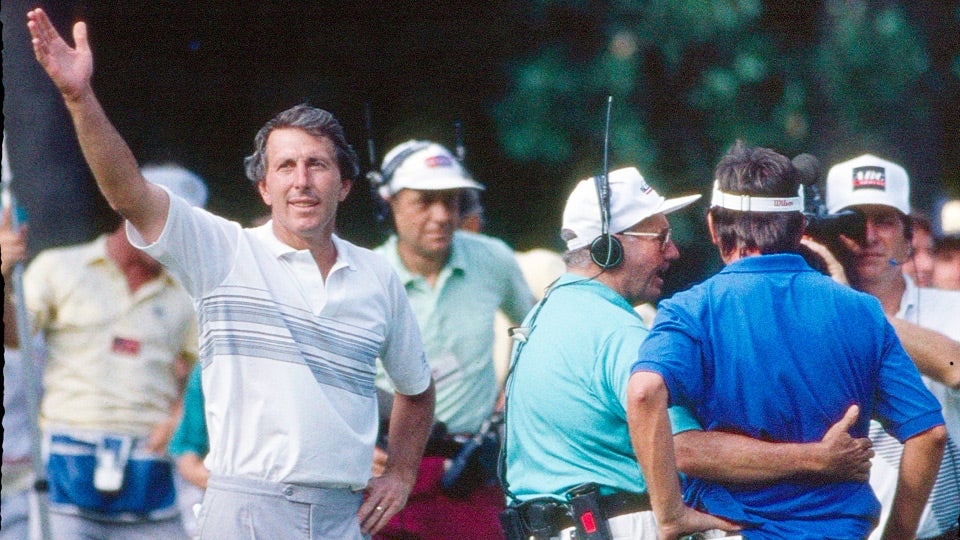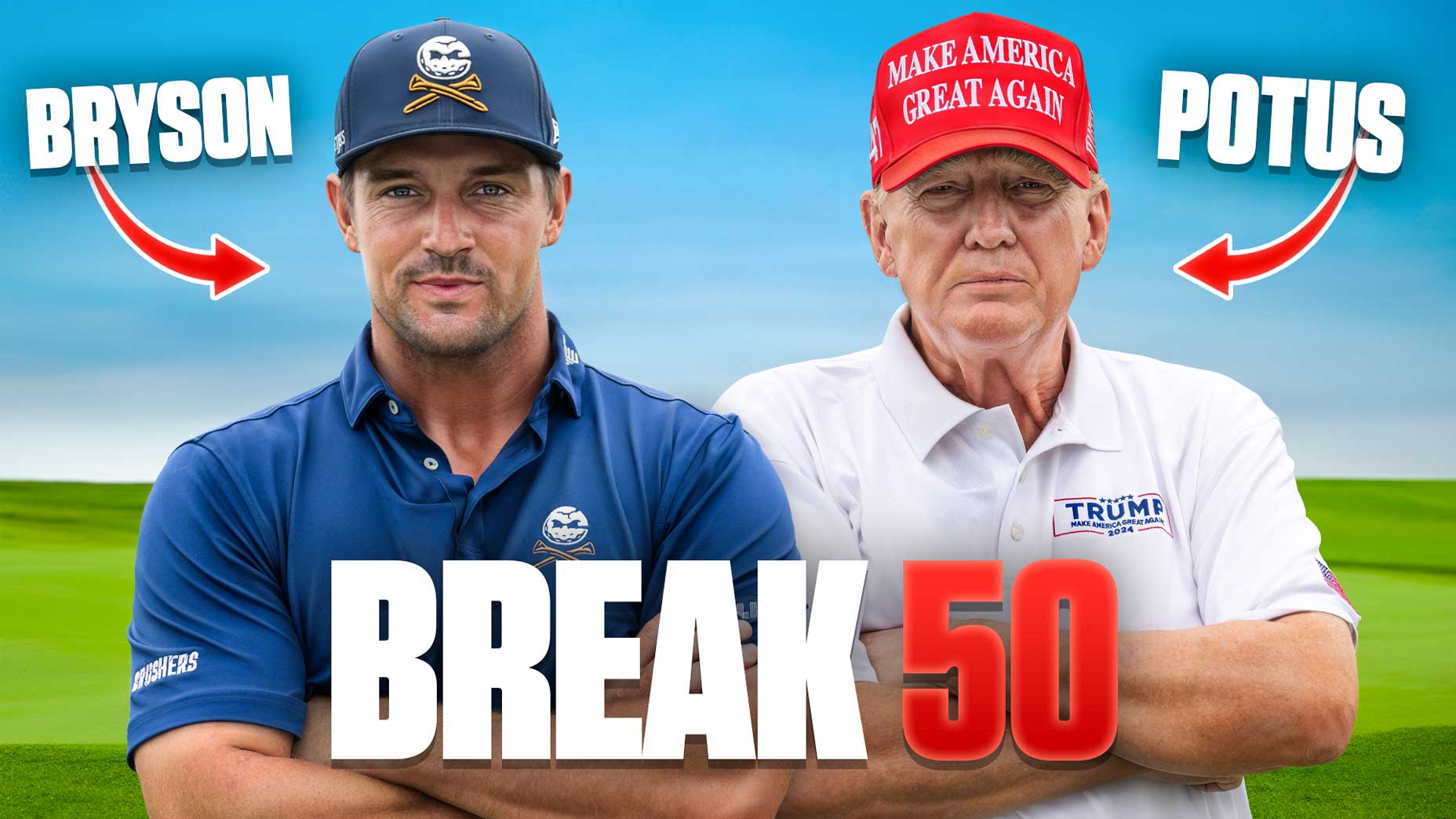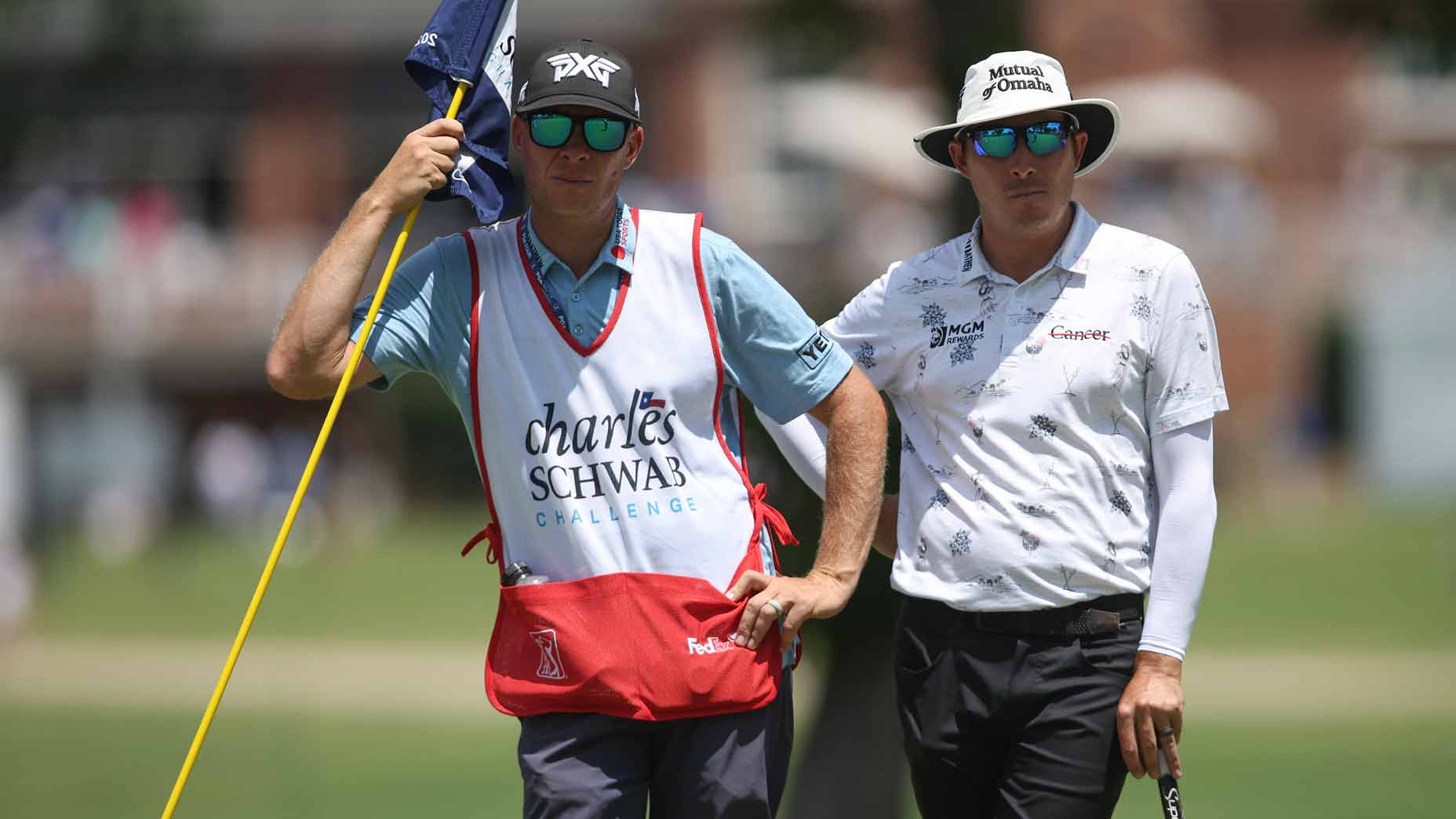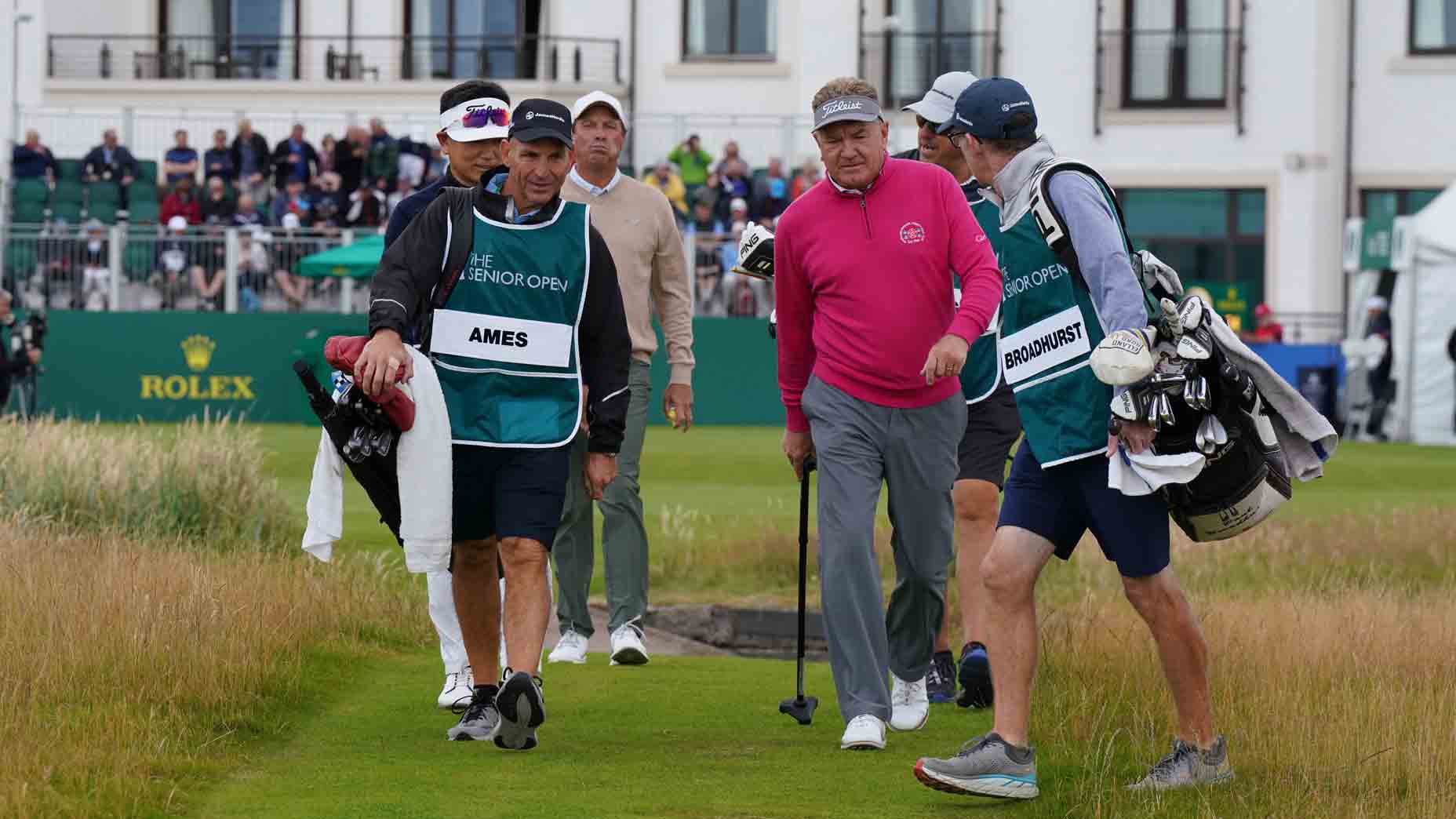You wouldn’t call Rory McIlroy a golf historian, but he does have an abiding curiosity about the game’s major championships. I am thinking of a moment a few years ago, when my friend Mike Donald and I ran into the lad at the Bear’s Club, a Jack Nicklaus enterprise in South Florida. When I introduced Mike to Rory, I detected just a hint of recognition on his map-of-Ireland face. Mike won one Tour event, in 1989, the year Rory was born, and my sense was that Rory knew Mike’s name. Beyond that he seemed to be drawing a blank.
The next day I saw Rory in the locker room at the Honda Classic. He was the reigning U.S. Open champion, and I asked him if he knew anything about Mike’s U.S. Open highlight. He didn’t, but he was happy to learn something.
“In the ’90 Open at Medinah, Mike lost to Hale Irwin in a 19-hole playoff,” I said. In other words Mike was one shot away from having his name on the trophy that was then in Rory’s possession. I reached for language I knew Rory would understand. “Mike was Rocco before there was a Rocco.”
For you kids out there: In the 2008 U.S. Open at Torrey Pines, Rocco Mediate, working-class Tour player, was tied with Tiger Woods, the ultimate golfing Brahmin, after 72 holes. They remained tied after an 18-hole Monday playoff. Mediate then lost on the first hole of sudden death. Irwin in 1990 was already a slam-dunk Hall of Famer. Donald was, as his friend Jack Welch once called him, “a grunt.” (A compliment from the then GE boss.) The progenitor of both of these mano-a-mano playoff mismatches was Ben Hogan vs. Jack Fleck at the ’55 Open at Olympic, except in that one David beat Goliath. Open playoffs — drawn-out afternoon affairs, 18 holes at a minimum, often contested in stifling heat — are memorable. There’s the first act, to get into it. The second act, the playoff itself. And the third, the what-could-have-been act. It is true theater. As much as anything in golf, Open playoffs brush against the nub of life.
Rory didn’t need a playoff at Congressional in 2011. He won his U.S. Open by eight. Still, upon learning about the 91-hole Open in 1990, he nodded knowingly.
The Sunday afternoon of that Open, celebrating its silver anniversary this year, unfolded like a long, tense movie. Dave Marr reminded TV viewers more than once that almost a dozen guys were in position to match or beat the 45-year-old Irwin, who was in the house early at eight under. (Raise your hand if you remember when the Open was on ABC.) Phil Mickelson and David Duval, each playing in his first Open, were vying for low amateur. Nicklaus, already a winner on the Senior tour, had shot a stop-time, third-round 68. Nick Faldo, high priest of fairways-and-greens golf, finished a shot out of the playoff. Greg Norman, still using a wooden driver, shot a pair of 69s on the weekend. Curtis Strange was looking to win his third consecutive Open. Medinah ’90 has had legs.
Mickelson arrived in Chicago as a teenager and turned 20 on U.S. Open Saturday. Jim Mackay, newly nicknamed Bones, was caddying for Larry Mize that week and remembers hearing fans sing “Happy Birthday” to his future boss from across a fairway. Mickelson remembers the punishing rough, his solid play, the challenge and the excitement.
“I got to three under through 14 on Sunday, and I felt like I had a chance to win the national Open,” Mickelson said recently. “Nobody else would say I was really in it, but that’s how I felt.”
Young Phil leaked oil over the final four holes, but he still shot even par and was the low amateur, five shots ahead of Duval. Mickelson left town believing he would someday win the Open, and nothing has changed since. “I’m going to Chambers Bay still thinking I can win a U.S. Open,” he said. “Or my second British Open,” a nod to a course that is brackish, wide and windblown. Medinah in 1990, he said, “feels like yesterday, maybe five years ago, tops.” The persistent question, Mickelson said, through all these years is this: “When do you stop learning and start executing and win the damn thing?”
Medinah was the first U.S. Open for Mike Davis as well, at least as a USGA employee. He was 25 then and just starting his career in Far Hills. Now he is the USGA’s executive director, and Chambers Bay is his baby as much as anybody else’s, at least until the opening bell goes off. Davis, like Donald, played college golf at Georgia Southern, but a decade later.

“When Mike and Hale went to the first tee to play that 19th hole, my radio went off,” Davis said recently. “There wasn’t a pin on the 1st green! The flagsticks had already been collected, from the first time they went through. I grabbed the flagstick off the 18th green and ran it over to the 1st green. If you look at the pictures from that last hole, you can see the flag has 18 on it.” Eighteen years later Davis would be the USGA official overseeing the Woods-Mediate playoff at Torrey.
On that Monday at Medinah, Donald and Irwin each shot 74, two over. Irwin made a par on 18, Donald a bogey, and they signed their cards. P.J. Boatwright, the USGA executive officiating the playoff, then gave Irwin the honor when they returned to the 1st, because of the scores on 18. Donald argued that they had just completed a stroke-play round and were going to begin a different competition, this one being played in sudden death, which the USGA had never had to use before. Boatwright then said Irwin would play first because he had the honor at the day’s start. Donald said they should draw for the honor. Tour players typically want to play first in such situations. You drive it in play, you put pressure on the other guy to do the same.
Boatwright, working what would be his final Open (he died in 1991), rejected Donald’s argument. It was the second rules brush between the two in a matter of months. During the second round at the Masters, Donald hit a stubby snap-hook off the 18th tee. His ball bounced off a restroom roof and disappeared into a drain. Donald sought a free drop, but Boatwright made him play as if his ball had finished in a water hazard. Boatwright had to know what Donald, called Mad Dog by some of the Tour caddies, thought of his ruling. It’s worth noting that Donald was on his way to shooting 82 that day and answered every last question from reporters, just as he had done the first day, when he shot 64.
That week Donald caught the eye of the great Jim Murray of The Los Angeles Times, who, in a USA Today poll at Medinah, picked Donald, then 34, to win. The man was a genius. In his column for the Monday of the playoff, Murray wrote, “If [Donald] wins, I’ll try not to say I told you so. Nobody likes know-it-alls. But I had him in the pool, too.”
Murray was surely watching when Irwin, Donald and Boatwright assembled on the 1st tee for the second time on that Monday, for the day’s 19th hole. Irwin hit it right down the sprinkler line. He followed with a sand iron (his phrase) to about 10 feet and made the putt for three that won him his third U.S. Open. He was the oldest player to win an Open and the first to win playing on a special exemption granted by the gents in Far Hills.
Donald, who had about a four-footer for par, picked up his marker and plucked Irwin’s ball out of the hole while the champ did a little dance. “My game opened up like an accordion, and I made some beautiful music,” Irwin said years later of his play at Medinah. Donald figured Irwin would want his game ball. He knew its significance. Only four men had won four Opens: Nicklaus, Hogan, Bobby Jones and Willie Anderson. Medinah gave Irwin a hat trick, the lone man at three until Tiger won at Torrey Pines. Irwin’s victory put him in the pantheon. Hale Irwin. Whisper thy name.
Fast-forward 18 years. “When Rocco and Tiger finished their 18-hole playoff, I had them sign their cards right there on the green,” Davis said. “Then, as I recall it, we flipped a coin to see who would have the honor on the 19th hole.” You may call it, if you like, the Mike Donald Rule.
Nicklaus was 50 at the 1990 Open. After winning the ’86 Masters, he had started calling himself a “ceremonial golfer,” to lower expectations. He made the cut on the number at Medinah (one over) and then shot the third-round 68. Nobody shot lower that day. Some ceremonial golfer. By Saturday night Nicklaus was only four shots off the lead.
You might want to know Jack’s mind-set going into the final round. You could imagine him thinking something like, Another 68 and I can win this thing. I wish I could tell you.
Nicklaus’s mind is his greatest asset, and his memory is extraordinary. At least, it is for his wins and for many of his runner-up finishes — 19 in major championships alone. But the 1990 U.S. Open, where he finished in the middle of the pack, has all but vanished from his mind. He knows that Irwin won and Donald did not, and that’s about it.
“I forgot I made the cut,” Nicklaus said the other day, accompanied by the Jack chuckle. “I thought I watched the final round from home on TV.” He most likely did, but he would have been watching the fifth round, not the fourth.
Memory is imperfect, of course, and many people have one or two major misconceptions about the 1990 Open. They have seen the clip of Irwin making a 45-foot birdie putt on 18 on Sunday and think that was the winning putt. It sticks in your head: Hale Irwin, in red pants and impossibly fit, makes a bomb and then sprints around the perimeter of the home green as if he’s a human Indy car while high-fiving everyone in sight. But that putt was actually the exclamation mark to a Father’s Day 67 that got him to eight under through 72 holes.

Donald and Billy Ray Brown, the 54-hole coleaders, were playing two hours behind him. Also on Medinah’s back nine were, among others, Strange, Faldo, Norman, Nicklaus, Mickelson, Mize, Seve Ballesteros, José María Olazábal and Fuzzy Zoeller, all major talents with at least a chance of posting eight under, if not better. Low was out there. Irwin had shot a back-nine 31.
Though he was only two shots back through 54 holes, Strange couldn’t get a good thought in his head. He had changed his putter after two rounds and promptly shot 68, but after making a bogey on the par-3 2nd hole on Sunday, he felt “like the wind was out of my sails,” he said recently.
“I wasn’t playing that well, leading up to that Open,” he added, “so I went in thinking I didn’t really have the gun power I needed, but that if my putter got hot I could win.”
It was stressful for Strange. Not just the four rounds at Medinah, but the weeks and months leading up to the event. No matter what he was doing, no matter where he was playing or practicing, somewhere in the back of his mind was the idea that he would be trying to win a third straight U.S. Open.
He closed with a three-over 75 and tied for 21st. But before leaving Medinah’s cavernous multidomed clubhouse, Strange made an uncharacteristic gesture for him: He left Donald a good-luck note.
Medinah was built by the Shriners in the showy height of the Jazz Age and is named for an ancient Arabian city. There are Far Eastern touches in unexpected places, including a small exit sign that reads allah be with you. Strange watched the end of the Sunday play, wrote his note, packed up and got a ride to O’Hare. During the trip to the airport, Strange said recently, “a feeling of relaxation just washed over me.” He had spent two years alone on the mountaintop and now he was coming down. He never won again, on any tour.
[pagebreak]
This year, for the first time in forever, Strange won’t attend the U.S. Open. He played his last Open in 2000, and for years after that he was a regular presence as an ESPN commentator. But now, for the first time, the U.S. Open, all four rounds of it, will be a Fox Sports enterprise. “I’ll be happy to watch it from home,” Strange said. U.S. Opens are exhausting.
Donald played in only two more U.S. Opens after Medinah, missing the cut the following year at Hazeltine and finishing T-33 at Baltusrol in ’93. A couple of years ago Mike and I visited Curtis at his home in Morehead City, in coastal North Carolina. The two aren’t close friends, but they share certain traits. They are both blunt and practical. Curtis turned 60 in January, and Mike will turn 60 in July. They compared notes about players and swings and courses. They are both rich, when you get right down to it. Rich in banked money, in memories, in appreciation for the game and what it has given them. The scales might be different, but that doesn’t matter.
Which brings me to the other misconception that comes out of the 1990 Open, though it is not nearly as widespread as the actual significance of Irwin’s 45-foot putt. And it is this: There are many people who think that Medinah somehow broke Mike, dented his spirit, wrecked his game. And in truth the ’90 Open did have a significant impact on Mike’s golf. His swing was different and better at Medinah than it had ever been, less handsy, more authoritative. But for some reason he couldn’t make that U.S. Open swing stick, and he spent years trying to re-create it. Mike wouldn’t want this part sugarcoated: His game did desert him after Medinah. But he never stopped being a grunt. He never stopped trying to figure things out, in the game and beyond it.
About six months after Mike and I saw Curtis, we had a similar visit with Nicklaus, in his office sandwiched between U.S. 1 and Lake Little Worth, in South Florida. It was part of a book project for which Mike and I logged a lot of days and many miles together. We both hold Big Jack in the highest esteem. Jack knows what it means to win and to lose, just as Phil does and Curtis does, just as Mike does, just as you and I do too, when you get right down to it.
“To get beat is very healthy, particularly when you’ve given it your best effort,” Jack told us late in our stay.
We hadn’t been talking specifically about the 1990 U.S. Open, but I felt it was in the air, like the hum of a distant mower.
“If you win every time, you don’t learn anything,” Jack said. In a finger-snap he had moved way beyond golf. “You don’t learn anything about yourself. You don’t learn anything about the game. You don’t learn anything about life.”
For more news that golfers everywhere are talking about, follow @golf_com on Twitter, like us on Facebook, and subscribe to our YouTube video channel.








